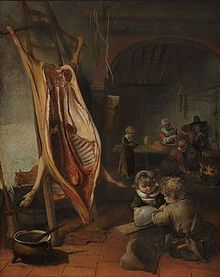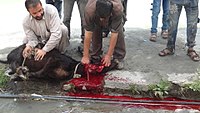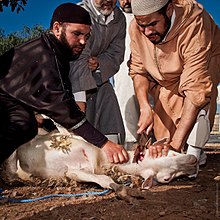
Islamic dietary laws are laws that Muslims follow in their diet. Islamic jurisprudence specifies which foods are halal and which are haram. The dietary laws are found in the Quran, the holy book of Islam, as well as in collections of traditions attributed to the Islamic prophet Muhammad.

Animal sacrifice is the ritual killing and offering of one or more animals, usually as part of a religious ritual or to appease or maintain favour with a deity. Animal sacrifices were common throughout Europe and the Ancient Near East until the spread of Christianity in Late Antiquity, and continue in some cultures or religions today. Human sacrifice, where it existed, was always much rarer.
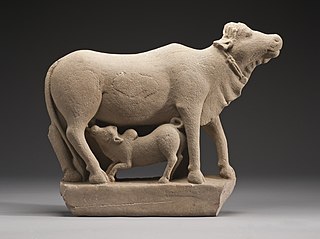
There are varying beliefs about cattle in societies and religions.

Eid al-Adha or the Feast of Sacrifice is the second of the two main holidays celebrated in Islam. In Islamic tradition, it honours the willingness of Abraham to sacrifice his son as an act of obedience to God's command. Depending on the narrative, either Ishmael or Isaac is referred to with the honorific title "Sacrifice of God". However, before Abraham could sacrifice his son in the name of God, and because of his willingness to do so, God provided him with a lamb to sacrifice in his son's place. In commemoration of this intervention, animals such as lambs are sacrificed. The meat of the sacrificed animal is divided into three portions: one part of the meat is consumed by the family that offers the animal, one portion is for friends and relatives, while the rest of the meat is distributed to the poor and the needy. Sweets and gifts are given, and extended family members typically visit and are welcomed. The day is also sometimes called the "Greater Eid".

There are two official holidays in Islam that are celebrated by Muslims worldwide: Eid al-Fitr and Eid al-Adha. The timing of both holidays are set by the lunar Islamic calendar, which is based upon the cycle of the moon, and so is different from the more common, European, solar-based Gregorian calendar. Every year, the Gregorian dates of the Islamic holidays change.

The practice of vegetarianism is strongly linked with a number of religious traditions worldwide. These include religions that originated in India, such as Hinduism, Jainism, Buddhism, and Sikhism. With close to 85% of India's billion-plus population practicing these religions, India remains the country with the highest number of vegetarians in the world.

Qurbān or uḍḥiyah as referred to in Islamic law, is a ritual animal sacrifice of a livestock animal during Eid al-Adha.
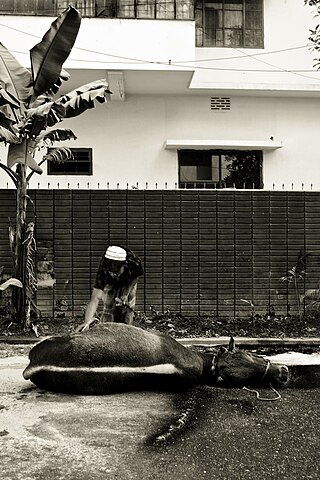
In Islamic law, dhabihah, also spelled zabiha, is the prescribed method of slaughter for halal animals. It consists of a swift, deep incision to the throat with a very sharp knife, cutting the wind pipe, jugular veins and carotid arteries on both sides but leaving the spinal cord intact. The butcher is also required to call upon the name of Allah (Bismillah) individually for each animal.
The Islamic dietary laws (halal) and the Jewish dietary laws are both quite detailed, and contain both points of similarity and discord. Both are the dietary laws and described in distinct religious texts: an explanation of the Islamic code of law found in the Quran and Sunnah and the Jewish code of laws found in the Torah, Talmud and Shulchan Aruch.

The legal aspects of ritual slaughter include the regulation of slaughterhouses, butchers, and religious personnel involved with traditional shechita (Jewish) and dhabiha (Islamic). Regulations also may extend to butchery products sold in accordance with kashrut and halal religious law. Governments regulate ritual slaughter, primarily through legislation and administrative law. In addition, compliance with oversight of ritual slaughter is monitored by governmental agencies and, on occasion, contested in litigation.
Jhatka, or Jhataka, is the meat from an animal killed by a single strike of a sword or axe to sever the head within the Sikh religion, which kills the animal almost instantly as opposed to other forms of slaughter. This type of slaughter is preferred by most Sikhs, as well as meat-consuming Hindus and Buddhists. Also within this method of butchering the animal must not be scared or shaken before the slaughter.
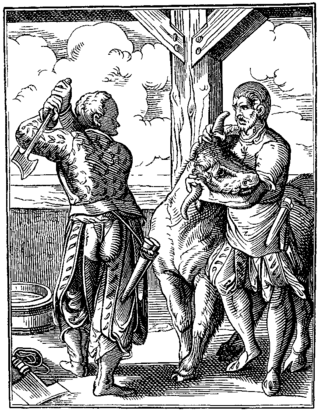
Animal slaughter is the killing of animals, usually referring to killing domestic livestock. It is estimated that each year, 80 billion land animals are slaughtered for food. Most animals are slaughtered for food; however, they may also be slaughtered for other reasons such as for harvesting of pelts, being diseased and unsuitable for consumption, or being surplus for maintaining a breeding stock. Slaughter typically involves some initial cutting, opening the major body cavities to remove the entrails and offal but usually leaving the carcass in one piece. Such dressing can be done by hunters in the field or in a slaughterhouse. Later, the carcass is usually butchered into smaller cuts.
Ritual slaughter is the practice of slaughtering livestock for meat in the context of a ritual. Ritual slaughter involves a prescribed practice of slaughtering an animal for food production purposes.
The cow protection movement is a predominantly Indian religious and political movement aiming to protect cows, whose slaughter has been broadly opposed by Hindus, Buddhists, Jains, Zoroastrians and Sikhs. While the opposition to slaughter of animals, including cows, has extensive and ancient roots in Indian history, the term refers to modern movements dating back to colonial era British India. The earliest such activism is traceable to Namdhari (Kooka) Sikhs of Punjab who opposed cow slaughter in the 1860s. The movement became popular in the 1880s and thereafter, attracting the support from the Arya Samaj founder Swami Dayananda Saraswati in the late 19th century, and from Mahatma Gandhi in the early 20th century.
Nikkur is the process of making an animal kosher by removing chelev and the gid hanasheh. The basis for this practice is Leviticus 7:23, "You shall not eat of any fatty suet, whether from cattle, sheep, or goats." The English word porge, or porging is from Judeo-Spanish porgar ; the Yiddish is treibern. The process is done by a menakker.

Roadkill cuisine is preparing and eating roadkill, animals hit by vehicles and found along roads.
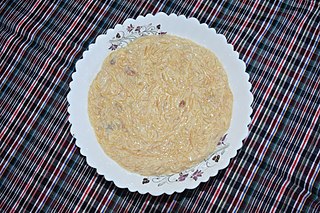
Both festivals of Eid celebrated in the Muslim world include cuisines specific to countries and localities.
Islamic vegetarianism and veganism is the practice of abstention from meat among Muslims. The vast majority of Muslims eat meat; many Islamic jurists consider vegetarianism permissible but not superior to meat-eating. The religious arguments for the vegetarian diet include the requirement for compassion imposed on Muslims by Quran and sunnah and the concept of stewardship (khalifa). Modern vegetarian Muslims often encounter prejudice for their diet. A particular case is the tradition of killing an animal during the celebration of the Eid al-Adha, which many Muslims see as compulsory despite the view of most scholars; several faqih spoke in favour of replacing the slaughter with giving to charity.
Animal welfare and rights in India regards the treatment of and laws concerning non-human animals in India. It is distinct from animal conservation in India.
Eid al-Adha is a festival celebrated by Muslims in Nigeria and all over the world on the 10th day of the Hijri month of Dhu al-Hijja. It is one of two official holidays celebrated in Islam. It honors the willingness of Ibrahim (Abraham) to sacrifice his son Ismail (Ishmael) as an act of obedience to Allah's command.
